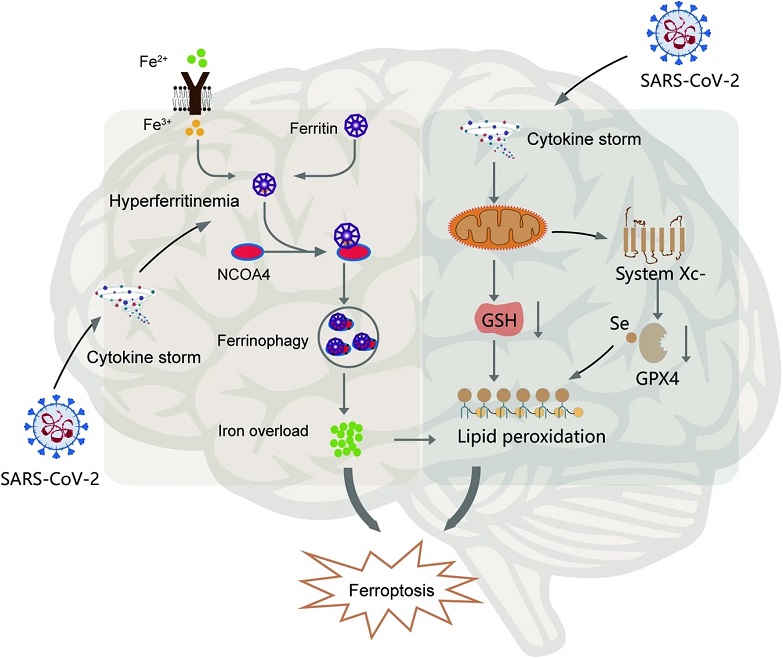Ferroptosis Possibly Behind COVID-19 Induced Parkinson’s Disease Neurological Manifestations
Nikhil Prasad Fact checked by:Thailand Medical News Team Mar 26, 2024 1 year, 2 weeks, 6 days, 4 hours, 49 minutes ago
COVID-19 News: In recent times, an increasing number of cases have emerged, pointing towards a potential connection between SARS-CoV-2 infection and the onset of Parkinson’s disease (PD) in patients. However, the intricate mechanisms by which the SARS-CoV-2 virus affects the brain and triggers neuropsychiatric symptoms in COVID-19 patients remain largely unknown. One emerging area of research that holds promise in unraveling this mystery is ferroptosis, a distinct iron-dependent non-apoptotic form of cell death characterized by lipid peroxidation and glutathione depletion, which has been implicated in various neurological disorders. While recent findings suggest a potential pathogenic role of ferroptosis in COVID-19, its specific contributions to COVID-19-related PD have yet to be thoroughly investigated. This
COVID-19 News report covers a study review by researchers from Qingdao University-China that aims to delve into potential pathways of SARS-CoV-2 infection in the brain, with a particular focus on ferroptosis and its potential implications for COVID-19-related PD, along with possible therapeutic interventions.
 The involvement of ferroptosis in SARS-CoV-2 infection related to Parkinson’s Disease. SARS-CoV-2 infection may lead to ferroptosis for PD pathogenesis, probably contributing to the initiation of the disease through two major pathways: transporter-dependent pathway with iron imbalance and the intrinsic or enzyme regulated pathway.
Understanding the Landscape: COVID-19 and Parkinson’s Disease
The involvement of ferroptosis in SARS-CoV-2 infection related to Parkinson’s Disease. SARS-CoV-2 infection may lead to ferroptosis for PD pathogenesis, probably contributing to the initiation of the disease through two major pathways: transporter-dependent pathway with iron imbalance and the intrinsic or enzyme regulated pathway.
Understanding the Landscape: COVID-19 and Parkinson’s Disease
The global impact of COVID-19 has been unprecedented, with far-reaching implications beyond its immediate respiratory effects. Emerging evidence suggests that the SARS-CoV-2 virus, responsible for the ongoing pandemic, not only targets the respiratory system but also affects other organs and tissues, including the brain. Recent studies have detected SARS-CoV-2 in neurons within various brain regions, including the substantia nigra.
Additionally, a significant proportion of COVID-19 patients have reported experiencing acute and subacute neurological complications. Given that PD is characterized by a loss of dopaminergic neurons in the substantia nigra and subsequent striatal dopamine depletion, individuals with PD exhibit a range of motor and non-motor impairments. This review aims to explore the current understanding of potential pathogenic links between COVID-19 and PD, with a specific focus on ferroptosis as a potential therapeutic target.
Neurotropism of COVID-19 and its Implications for PD
COVID-19 has been shown to disrupt the central nervous system (CNS) through various mechanisms, including direct invasion of neuronal cells by SARS-CoV-2, systemic inflammation leading to neuroinflammation, respiratory failure-associated brain ischemia, and other pathways.
Notably, anosmia and ageusia, n
eurological symptoms observed in a significant percentage of COVID-19 patients, are early indicators that may have implications for PD development. Studies suggest that SARS-CoV-2 can enter the brain via olfactory neurons, bypassing initial lung involvement. This direct access to brain regions, including the basal ganglia and brainstem, raises concerns about potential neurodegenerative effects, including those related to PD.
Exploring Potential Mechanisms: Ferroptosis and its Role in COVID-19-Related PD
Ferroptosis, characterized by iron-dependent lipid peroxidation and glutathione depletion, has emerged as a potential player in COVID-19 pathogenesis. Recent studies have identified a ferroptosis signature in tissues of COVID-19 patients, highlighting its role in organ damage. In the context of PD, ferroptosis has been implicated in the death of dopaminergic neurons, a hallmark of the disease. Animal studies using ferroptosis inhibitors have shown promising neuroprotective effects, suggesting that targeting ferroptosis could be a viable therapeutic strategy for PD. However, the specific contributions of ferroptosis to COVID-19-related PD remain to be fully elucidated.
The Interplay of Iron Metabolism and Oxidative Stress in COVID-19-Related PD
Iron metabolism dysregulation, a key feature of both PD and COVID-19, has been observed in COVID-19 patients and is associated with disease severity. Iron accumulation can lead to oxidative stress and lipid peroxidation, contributing to ferroptosis. Targeting iron metabolism pathways, such as ferritinophagy, may offer potential therapeutic avenues for COVID-19-related PD. Similarly, the glutathione peroxidase 4 (GPX4) axis, crucial in protecting against ferroptosis, is disrupted in COVID-19, further highlighting the potential role of ferroptosis in disease pathogenesis.
Clinical Implications and Future Directions
While the links between COVID-19 and PD are becoming clearer, several challenges and unanswered questions remain. Establishing causal relationships, understanding the impact of viral mutations, and unraveling the cross-talk among different cell death pathways are areas that require further investigation. Clinical trials evaluating ferroptosis inhibitors in COVID-19-related PD are needed to validate its therapeutic potential. Additionally, exploring combinatorial approaches targeting inflammation and ferroptosis could offer synergistic benefits in managing COVID-19-related PD.
Conclusion
In conclusion, ferroptosis emerges as a promising avenue for understanding the pathogenesis of COVID-19-related PD. The interplay of iron metabolism dysregulation, oxidative stress, and neuroinflammation underscores the potential role of ferroptosis in dopaminergic neuron death associated with PD. Targeting ferroptosis pathways holds therapeutic promise, although further research is warranted to delineate its precise contributions and develop effective treatment strategies for COVID-19-related PD. As we continue to unravel the complexities of COVID-19 neurotropism and its implications for neurological disorders like PD, ferroptosis stands out as a focal point for future investigations and therapeutic interventions.
The study findings were published in the peer reviewed journal: Cell Death Discovery (Springer Link).
https://link.springer.com/article/10.1038/s41420-024-01915-6
For the latest
COVID-19 News, keep on logging to Thailand Medical News.
